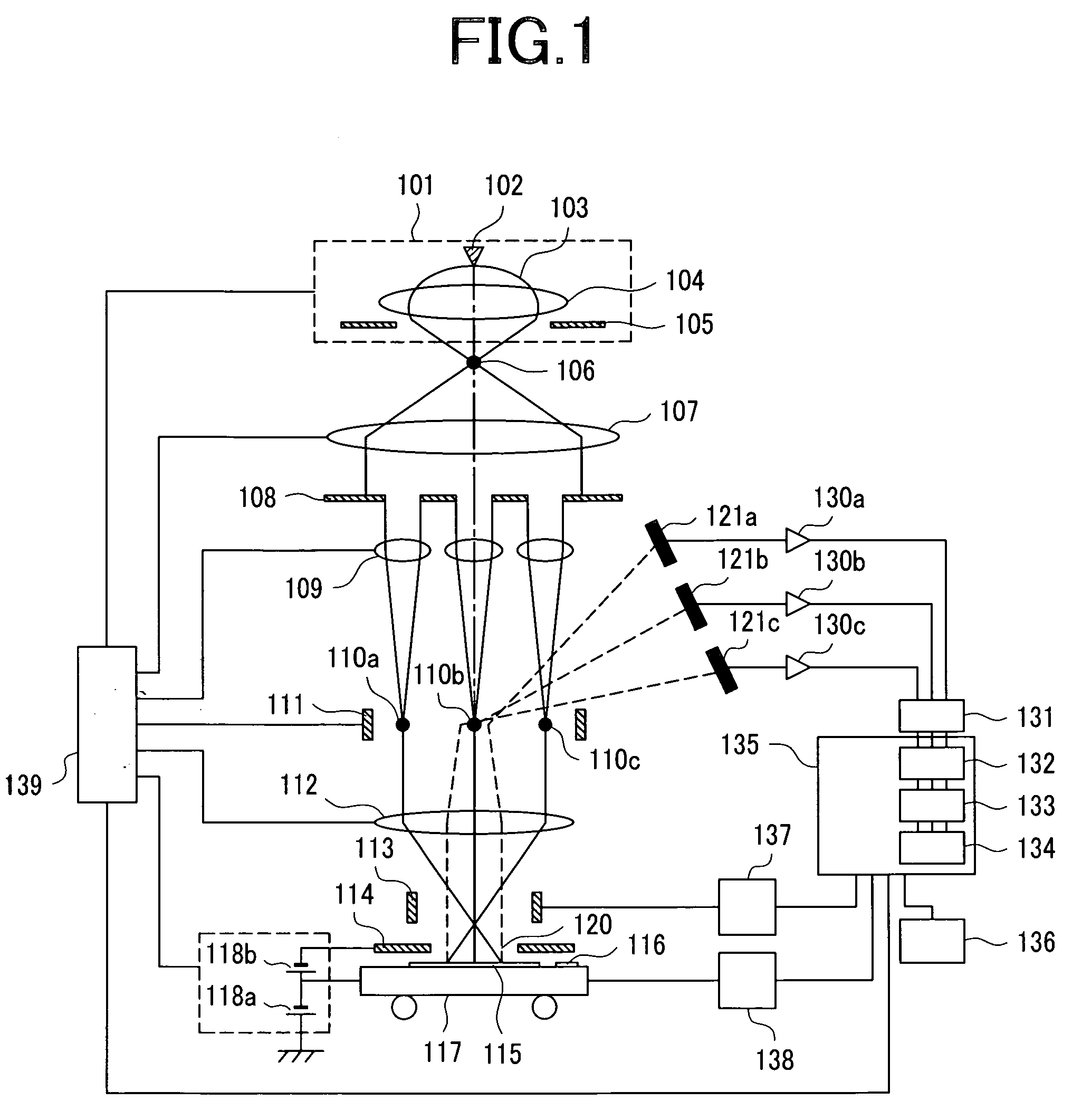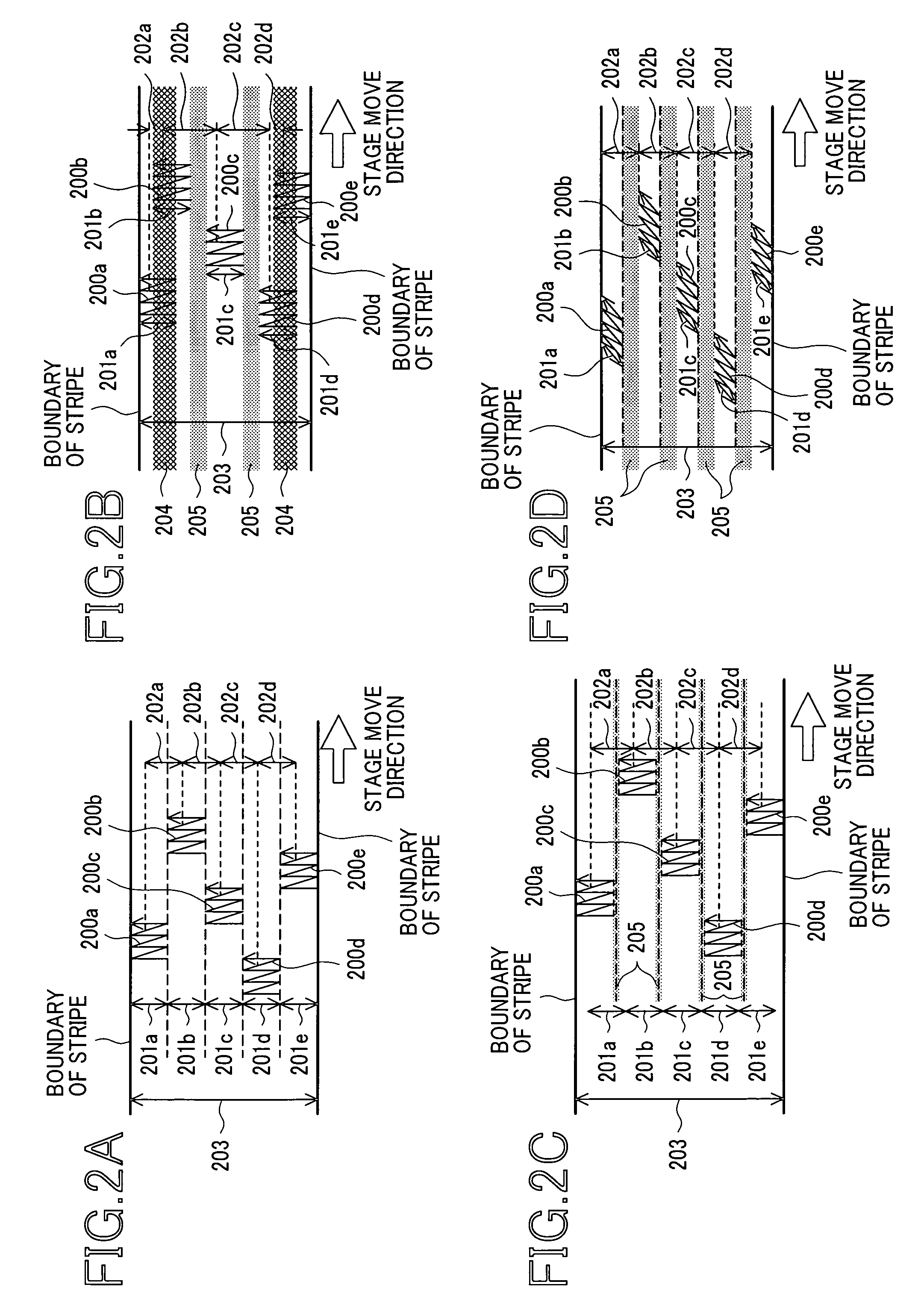Charged particle beam apparatus and specimen inspection method
a particle beam and apparatus technology, applied in the field of charged particle beam apparatus and specimen inspection method, can solve the problems of raster scanning shown in fig. 2a without an unscanned location, overlap becomes impossible, and similar problems
- Summary
- Abstract
- Description
- Claims
- Application Information
AI Technical Summary
Benefits of technology
Problems solved by technology
Method used
Image
Examples
first embodiment
[0037]FIG. 1 shows the schematic configuration of a multi-electron-beam inspection system equivalent to a first embodiment.
[0038]First, the configuration of the system will be described. An electron gun 101 includes a cathode 102 made of a material the work function of which is low, an anode 105 having higher electric potential than the cathode 102 and an electromagnetic lens 104 that superposes a magnetic field upon an accelerating electric field formed between the cathode and the anode. In this embodiment, a Schottky cathode in which emission current is large and the emission of an electron is stable is used. In a downstream direction in which a primary electron beam 103 is extracted from the electron gun 101, as shown in FIG. 1, there are arranged a collimator lens 107, an aperture array 108 plural apertures of which are arranged on the same substance, a lens array 109 having plural apertures, a beam separator 111, an objective lens 112, a deflector for scanning 113, a stage 117 ...
second embodiment
[0078]FIG. 7 shows the schematic configuration of an electron beam inspection system equivalent to a second embodiment.
[0079]When the configuration of the system in this embodiment is compared with that in the first embodiment, an electromagnetic lens 700 is added to a secondary optics system and an image of secondary electrons generated from a wafer 115 which is a specimen is extended and projected on secondary electron detectors 121a to 121c. A secondary beam 120 is rotated or is extended (is reduced) by the effect of an objective lens 112 and the electromagnetic lens 700 and the quantity of the rotation and the extension varies every inspecting condition like a layout when a primary beam reaches a surface of the wafer 115. Then, in this embodiment, the calibration of plural secondary beams is executed at the same time with the calibration of the primary beams.
[0080]FIGS. 8A to 8C are schematic plans showing secondary electron detector positions. When the rotation of plural second...
third embodiment
[0089]FIG. 11 shows the schematic configuration of an electron beam inspection system equivalent to a third embodiment.
[0090]When the configuration of the system in this embodiment is compared with that in the first embodiment, an aperture array 1100 and a mechanical operation control unit 1101 are added. Aperture arrays 108 and 1100 which are charged particle beam selecting devices and a lens array 109 are connected to the mechanical operation control unit 1101 and can be mechanically rotated by the control of a system controller 135. FIGS. 12A and 12B are schematic plans showing each aperture array 108, 1100. An aperture of the lens array 109 is similar to the aperture array 108 though the aperture is not shown in FIGS. 12A and 12B and the lens array 109 is rotated according to the rotation of the aperture array 108. At least two apertures are respectively formed in the aperture arrays 108, 1100.
[0091]In FIGS. 12A and 12B, (1) a group of apertures 1200a to 1200e in FIG. 12A and a ...
PUM
| Property | Measurement | Unit |
|---|---|---|
| thermal expansion coefficient | aaaaa | aaaaa |
| temperature | aaaaa | aaaaa |
| width | aaaaa | aaaaa |
Abstract
Description
Claims
Application Information
 Login to View More
Login to View More - R&D
- Intellectual Property
- Life Sciences
- Materials
- Tech Scout
- Unparalleled Data Quality
- Higher Quality Content
- 60% Fewer Hallucinations
Browse by: Latest US Patents, China's latest patents, Technical Efficacy Thesaurus, Application Domain, Technology Topic, Popular Technical Reports.
© 2025 PatSnap. All rights reserved.Legal|Privacy policy|Modern Slavery Act Transparency Statement|Sitemap|About US| Contact US: help@patsnap.com



